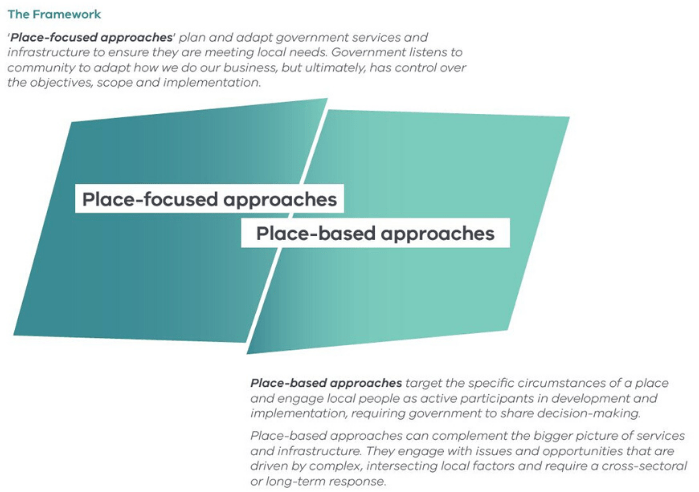Acknowledgement
We acknowledge Aboriginal people as the First Peoples and Traditional Owners and custodians of the land and water on which we all rely. We acknowledge that Aboriginal communities are steeped in traditions and customs, and we respect this. We acknowledge the continuing leadership role of the Aboriginal community in striving to redress inequality and disadvantage and the catastrophic and enduring effects of colonisation.
This framework is the start of a conversation about how we can resource, learn from and support place-based initiatives more consistently across government.
To tackle the broad opportunities and challenges facing us - urbanisation, inequality, intergenerational disadvantage, demographic shifts, environmental change - we need to see them from a local perspective and work with local people and communities.
Working with communities is a key capability for government
With higher expectations of government, the community’s trust in government institutions to meet their needs is declining. Interventions planned, funded and coordinated centrally by government are not enough to deal with the complex challenges that some Victorians face. In this context, ‘place’ can provide a
valuable focus point for government. It can help to:
- support civic engagement by enabling communities to apply local skills and strengths, and have a sense of ownership over decisions that are made
- think holistically and systematically by helping to understand how systems impact on people’s lives, and bring together players from different portfolios and sectors to develop solutions
- support preventative, cost effective responses by building resilient communities and targeting investment based on what works locally
To improve how we work in place, we need to improve how we understand and talk about it
Government has a long history of engaging with communities and working towards local solutions. Across government, we work in different ways to achieve these goals. Yet we often use similar language to talk about different ways of working that have different objectives.
This framework describes a way of thinking about place that will enable us to effectively communicate across government
The framework clarifies the difference between approaches that invite local communities to inform or contribute to government decision-making, and those where we hand over control or are an equal partner in decision-making with communities.
The Framework
'Place-focused approaches' plan and adapt government services and infrastructure to ensure they are meeting local needs. Government listens to community to adapt how we do our business, but ultimately, has control over the objectives, scope and implementation.
'Place-based approaches' target the specific circumstances of a place and engage local people as active participants in development and implementation, requiring government to share decision-making. Place-based approaches can complement the bigger picture of services and infrastructure. They engage with issues and opportunities that are driven by complex, intersecting local factors and requiring a cross-sectoral or long-term response.
Both approaches are equally valuable ways we can engage with local context
Both place-focused and place-based approaches engage communities, pay attention to local needs and wants, and leverage the passion and expertise of local people. Neither approach is better or worse; rather, they are used based on local context and what will be most effective in achieving outcomes for a community.
This framework will delve deeper into place-based approaches
This framework defines and describes the two approaches, and then delves deeper into place-based approaches to explain how they can be designed and implemented, and how government can better support them.
Because we know that is where government needs to build its capacity
We know that government could be better set up to support place-based approaches. Place-based approaches push up against traditional ways of working and our standard systems and processes. Current policies and practices can hinder the collaborative, cross-government and relational work that is crucial for successful initiatives.
Updated
